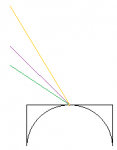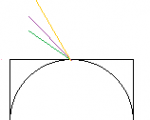Hmm. Earth is moving pretty quickly in space, so, depending on approach vectors, speeding the asteroid up or slowing it down a bit should generate enough 'miss' if you're far enough out.
For example, if the asteroid is crossing the orbit of Earth perpendicularly, the window to strike Earth is only 13,000 km / 30 km/s or about 435 seconds (about 7 and a quarter minutes). Assuming the asteroid aimed precisely at the center of Earth, you'd need to speed up or slow down the approach by half that 7 minute time, or about 4 minutes to be safe (240 seconds). A 4 minute delta in arrival time depends on the velocity of the asteroid and how long you take to start the acceleration. Assuming a 50 km/s speed on the asteroid, 4 minutes at 1 hour distance is a ratio: needed speed over current speed = needed time over original time. Or needed speed = original speed x (new time/old time). In this case, needed speed = 50km/s x (56 minutes/60 minutes) = 50 km/s x (.933) = 46.67 km/s. You'd need to generate a delta-v of 3.33 km/s at exactly 1 hour out (or earlier) to cause a complete miss. I think this is lower than the necessary delta-v to accelerate the mass sideways 6500 km over an hour (6500km/360 seconds = 18 km/s, so, yep, 6 times less).
Now, if your geometry has the asteroid coming in much closer to the orbital direction, this changes, as earth's relative movement is much less with respect to the path of the asteroid. However, a rock launched from the asteroid belt some time in the past should have a high angle of intercept to Earth's orbit, as it would be on a steep elliptical around the Sun. But, assuming a near head on collision, say at about a 20 degree approach, combined delta-v would be 30km/s (Earth) plus cosine(20)x50km/s or about 77 km/s. Earth relative speed on the perpendicular would be sin(20)x30km/s or about 10km/s. This puts a Earth on-target time window of 1300 seconds or 21.7 minutes. Again assuming a center strike, that's a time window of 11 minutes you have to modify. Needed speed up/slow down delta-v at 1 hour would be 14.7 km/s. This is still less than the needed perpendicular delta-v to cause a miss, although not much.
Orbital mechanics are funny. Often speeding up or slowing down along your path causes huge changes in orbit, while orthogonal thrusts change orbits more slowly. For the purposes of your story, gathering up a bunch of debris and smacking the asteroid just enough to slow it down would be sufficient for a high angle of intercept. This is the most likely scenario given the orbital geometries of a rock launched from the belt that's coming around again.
A neat way to tell this story might be that the angle of impact is such that meeting the asteroid and speeding it up is the right call (this would be the case if the asteroid was going to hit on the forward half of the Earth). Timing could be such that the push means the ateroid scrapes the atmo and skips, causing an awesome light show and placing the heroine at risk.





